Development of a learning management model based on the concept of constructionism in designing learning activities for students in the bachelor of education program to develop creativity and attitude of primary school students.
Keywords:
learning management model, constructionism, creativityAbstract
The objectives of this research were to 1) develop a learning management model based on the concept of constructionism in designing learning activities for students in the bachelor of education program to develop the creativity and attitude of primary school students, 2) study the results of designing learning activities for bachelor of education program students, 3) Study the results of using the learning management model for students. The target group used in this research were 30 bachelor of education program students and 40 primary school level students. The research tools consisted of 1) a learning management model, 2) a learning management plan, 3) assessment of learning activities for bachelor of education program students, 4) assessment of creativity of primary school students, 5) assessment of attitudes of primary school students. The research method has 4 steps: study and analysis, design and development, field experiment and evaluation and development. Statistics used in data analysis were mean ( ), standard deviation (S.D.), t-test, and content analysis.
The results of the research found that 1) the learning management model has 6 elements, including the importance of the model, principles, aims, and activity organizing steps, learning media, measurement and evaluation 2) The results of the design of learning activities for bachelor of education program students had a higher mean score after studying than before. 3) the results of using the learning management model with students in terms of creativity found that the average score after studying was higher than before studying and in terms of attitude towards the learning management model was at the highest level with an average score of 4.97.
References
ฆนัท ธาตุทอง. (2559). หลักการจัดการเรียนรู้. กรุงเทพฯ: เพชรเกษมการพิมพ์
ทิศนา แขมมณี. (2561). ศาสตร์การสอน. กรุงเทพฯ: โรงพิมพ์แห่งจุฬาลงกรณ์มหาวิทยาลัย.
ไพศาล หวังพานิช. (2530). วิธีการวิจัย. กรุงเทพฯ : มหาวิทยาลัยศรีนครินทรวิโรฒ ประสานมิตร.
รสริน เจิมไธสง. (2556). การพัฒนารูปแบบการเรียนการสอนเพื่อส่งเสริมความสามารถในการออกแบบการสอนอย่างไตร่ตรองเชิงวิพากษ์ของนักศึกษาครู. วารสารศึกษาศาสตร์ 15(2) : 26-33
เรวณี ชัยเชาวรัตน์. (2558). กระบวนการเสริมสร้างความสามารถในการออกแบบการเรียนการสอนของนักศึกษาปฏิบัติการวิชาชีพครูตรมแนวคิดชุมชนการเรียนรู้ทางวิชาชีพ. กรุงเทพฯ: สำนักพิมพ์จุฬาลงกรณ์มหาวิทยาลัย.
วิจารณ์ พานิช. (2555). วิถีสร้างการเรียนรู้เพื่อศิษย์ในศตวรรษที่ 21. กรุงเทพฯ: มูลนิธิสดศรี-สฤษดิ์วงศ์.
สำนักงานเลขาธิการสภาการศึกษา. (2563). นโยบายรัฐบาลด้านการศึกษา. [ออนไลน์]. สืบค้นเมื่อ 1 พฤษภาคม 2565. จากเข้าถึงได้จาก http://www.onec.go.th/th.php/page/category/CAT0000019.
Wong Yeou Min. (2014). The Analysis of UPSI Teacher Clinical Experience In Comparative Perspective and Suggession for New Teacher Clinical Experience Stucture. InternationalJournal for Innovation Education and Research. 2(11) : 14-23.
Downloads
Published
Issue
Section
License
Copyright (c) 2024 Mahamakut Buddhist University

This work is licensed under a Creative Commons Attribution-NonCommercial-NoDerivatives 4.0 International License.
บทความที่ได้รับการตีพิมพ์เป็นลิขสิทธิ์ของ มหาวิทยาลัยมหามกุฏราชวิทยาลัย วิทยาเขตสิรินธรราชวิทยาลัย
ข้อความที่ปรากฏในบทความแต่ละเรื่องในวารสารวิชาการเล่มนี้เป็นความคิดเห็นส่วนตัวของผู้เขียนแต่ละท่านไม่เกี่ยวข้องกับหาวิทยาลัยมหามกุฏราชวิทยาลัย วิทยาเขตสิรินธรราชวิทยาลัย และคณาจารย์ท่านอื่นๆในมหาวิทยาลัยฯ แต่อย่างใด ความรับผิดชอบองค์ประกอบทั้งหมดของบทความแต่ละเรื่องเป็นของผู้เขียนแต่ละท่าน หากมีความผิดพลาดใดๆ ผู้เขียนแต่ละท่านจะรับผิดชอบบทความของตนเองแต่ผู้เดียว



